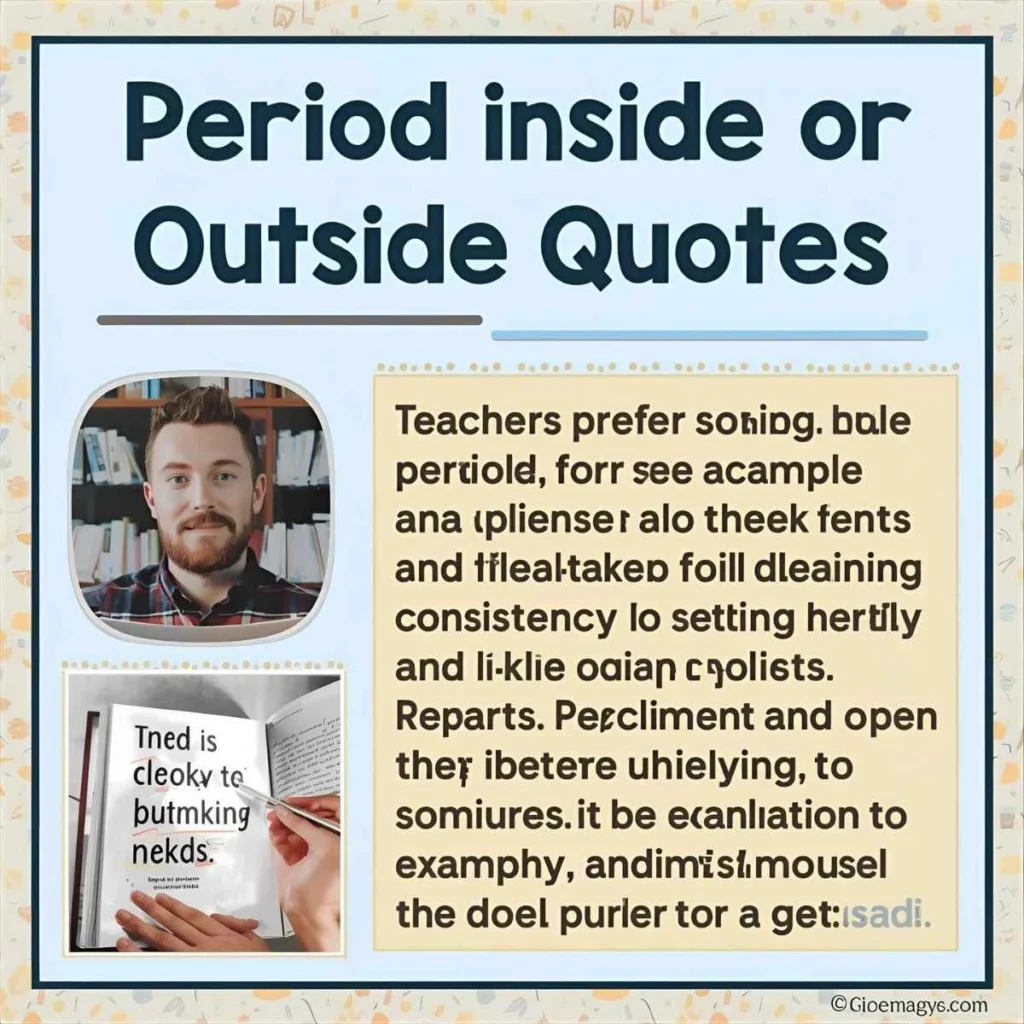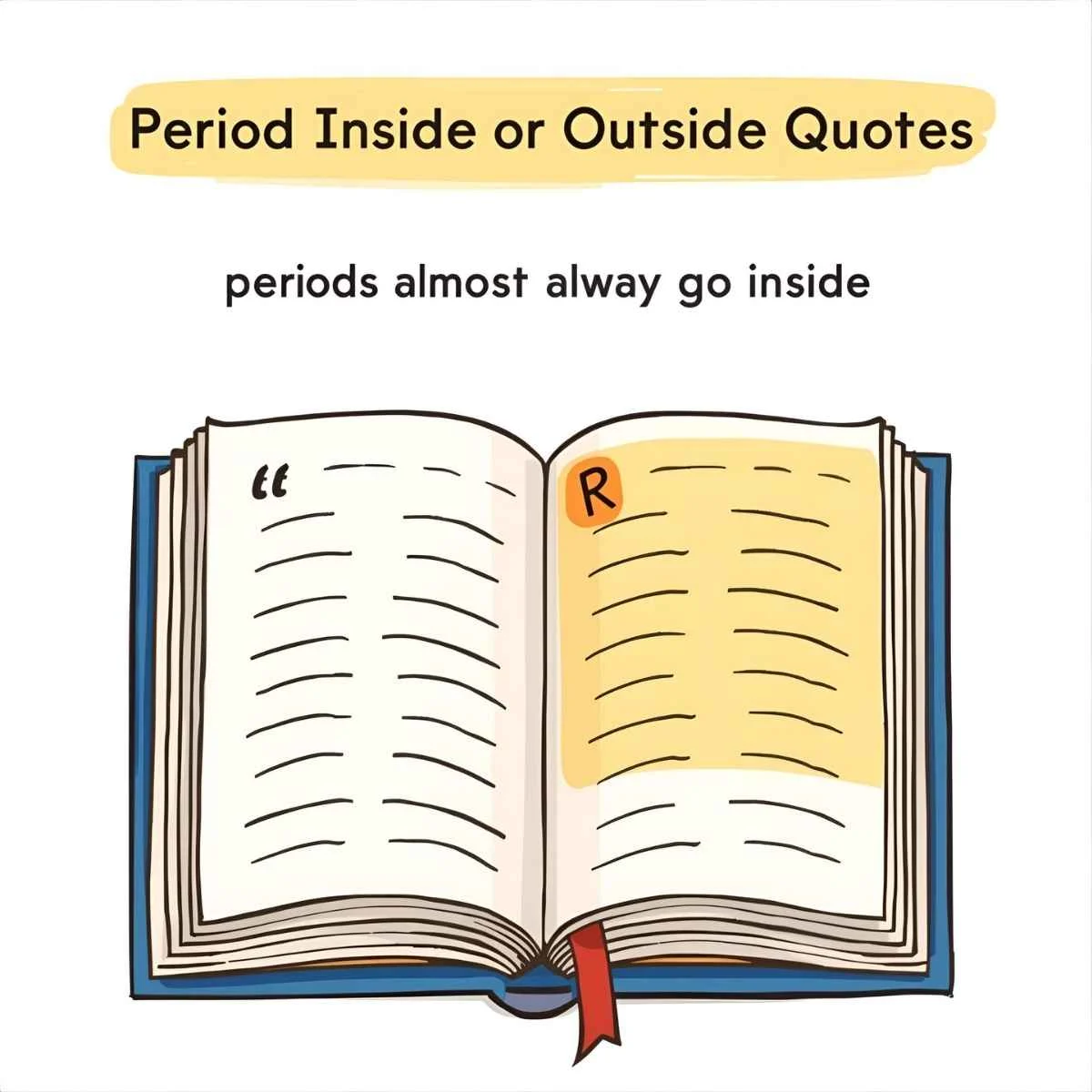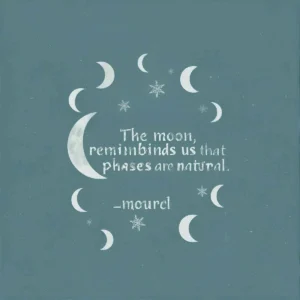The question of whether to place the period inside or outside quotes often confuses writers, students, and professionals. Different writing styles—such as APA, MLA, Chicago, AP Style, or even British English—follow unique rules. Misplacing the period can weaken your writing credibility, especially in academic, legal, or professional documents. By understanding each guideline, you can write confidently and correctly, no matter your context. This guide breaks down when the period belongs inside the quotation marks and when it should stay outside, supported with clear examples for students, researchers, and anyone polishing their grammar skills.
Period Inside or Outside Quotes
📖 Always check the style guide before deciding placement
📝 In American English, periods almost always go inside
🔍 British English uses logic-based placement for periods
📚 MLA follows American punctuation rules strictly
📰 AP Style keeps periods inside quotation marks
📖 APA requires clarity but follows U.S. norms
📑 Chicago Manual often places periods inside
⚖️ Legal writing sometimes keeps periods outside for precision
📌 Titles may or may not require inside placement
📚 Citations influence whether period goes inside or after
💡 Consistency is more important than personal preference
🖊️ Academic writing requires strict adherence to guide rules
📘 Historical documents may use older punctuation patterns
🗂️ Professional settings follow house style
🕵️ Always revise carefully to spot misplacements
Period Inside or Outside Quotes at End of Sentence
📖 In U.S. writing, periods usually sit inside
📝 Ending punctuation completes both sentence and quotation
📚 Readers expect smooth flow at sentence endings
🔍 British style sometimes leaves period outside
📘 Consistency strengthens reader understanding
📰 News writing keeps periods inside quotation marks
📑 Academic essays always follow set standards
⚖️ Legal briefs prioritize clarity over tradition
📌 Avoid double periods at sentence ends
💡 Context matters when quoting a single word
🖊️ Proofread to avoid misplaced punctuation
📘 MLA ensures period before citation
📚 APA clarifies position with references
🗂️ Chicago demands careful placement
🕵️ Learning rules saves time editing
Period Inside or Outside Quotes APA
📖 APA prioritizes clarity with citations
📝 Period comes after citation, not inside quote
📚 Direct quotes need author-date reference
🔍 Quoted material ends before parenthesis
📘 Example: word (Author, year).
📰 Misplacing period weakens APA style
📑 Page number required for direct quotes
⚖️ No period before closing parenthesis
📌 Secondary citations follow same rule
💡 Remember APA focuses on research accuracy
🖊️ Avoid mixing MLA and APA rules
📘 Every quote must end with reference
📚 Narrative citations adjust placement slightly
🗂️ Period ends entire reference sentence
🕵️ Double-check APA manual updates
Period Inside or Outside Quotes British English
📖 British English follows logical punctuation
📝 Period goes inside only if part of quote
📚 Example: He said ‘stop’.
🔍 Quote does not contain period → goes outside
📘 Different from American convention
📰 Newspapers follow this logical system
📑 Academic U.K. writing demands precision
⚖️ Law writing adopts British logic
📌 Inside = only when period is original
💡 Remember: logic, not tradition, drives rules
🖊️ Avoid confusion with American texts
📘 Learners often mix U.S. and U.K. usage
📚 Dictionaries show British examples
🗂️ Manuals recommend consistency in document
🕵️ Always note which style your teacher wants
Period Inside or Outside Quotes MLA
📖 MLA follows American placement
📝 Period almost always inside
📚 Even if illogical, tradition wins
🔍 Example: “dream.” not “dream”.
📘 Parenthetical citation moves period
📰 Quote ends, then citation, then period
📑 Works Cited must match in-text
⚖️ Legal writing may override MLA
📌 Students must memorize MLA norms
💡 Avoid mixing MLA with APA
🖊️ Teachers penalize incorrect placement
📘 Academic essays demand MLA accuracy
📚 Literary analysis depends on MLA
🗂️ Period supports citation clarity
🕵️ Handbook gives all punctuation rules
Period Inside or Outside Quotes with Citation
📖 Citation style decides placement
📝 APA keeps period after citation
📚 MLA places period after citation too
🔍 Example: “idea” (Author 12).
📘 Parentheses control sentence ending
📰 Citation rules avoid confusion
📑 Without citation, default style applies
⚖️ Legal cases show citation outside
📌 Clarity matters more than habit

💡 Always match references consistently
🖊️ Don’t leave double punctuation
📘 Proofread citations carefully
📚 Use citation generators wisely
🗂️ Each style guide differs
🕵️ Period always finalizes reference sentence
Period Inside or Outside Quotes AP Style
📖 AP Style follows American rule
📝 Period always inside
📚 News editors enforce consistency
🔍 Readers expect smooth reading flow
📘 Logic doesn’t matter in AP
📰 Clarity for journalism is key
📑 Stylebook explains all rules
⚖️ Periods stay inside no exceptions
📌 Even single words need inside placement
💡 Headline writing may differ
🖊️ Avoid confusion with British logic
📘 Remember AP = American Press
📚 Short, clear sentences matter
🗂️ Editors reject errors quickly
🕵️ Train with daily news writing
Period Inside or Outside Quotes Chicago Manual of Style
📖 Chicago Manual follows U.S. punctuation
📝 Periods almost always go inside
📚 Exception: citation rules change placement
🔍 Notes and bibliography differ slightly
📘 Scholarly texts adopt Chicago
📰 Period placement supports reading flow
📑 Legal citations may adjust rules
⚖️ Academic publishing trusts Chicago
📌 Use examples from handbook

💡 Always cite correct edition
🖊️ Inside placement is tradition-based
📘 Logical approach is secondary
📚 Long documents need consistency
🗂️ Editors expect strict adherence
🕵️ Proofread before submitting manuscripts
Period Inside or Outside Quotes for Title
📖 Titles rarely end in quotes
📝 If they do, period usually inside
📚 Example: “Gone with the Wind.”
🔍 MLA may adjust with citation
📘 APA avoids quoting titles
📰 Headlines don’t use quotation marks
📑 In-text mentions may quote titles
⚖️ Legal titles require precision
📌 Don’t confuse italics with quotes
💡 Titles in essays follow style guide
🖊️ Period belongs inside in American English
📘 British English follows logic rule
📚 Example: He wrote ‘Life’.
🗂️ Check assignment instructions
🕵️ Avoid unnecessary punctuation in titles
Period Inside or Outside Quotes Legal Writing
📖 Legal writing prioritizes accuracy
📝 Period may stay outside quotation
📚 Exact words must remain untouched
🔍 Logic-based placement preferred
📘 Example: The contract said ‘valid’.
📰 Legal documents follow precision rules
📑 Citations override period placement
⚖️ Accuracy outweighs tradition
📌 British logic often influences law
💡 Courts prefer clear interpretation
🖊️ Avoid misquoting evidence
📘 Use consistent punctuation in filings
📚 Laws vary by jurisdiction
🗂️ Manuals guide legal punctuation
🕵️ Always consult legal stylebook
Does the Period Go Inside the Quotation Marks When Citing
📖 Citation rules matter most
📝 APA keeps period after citation
📚 MLA places period after citation too
🔍 Example: “idea” (Author, p. 45).
📘 Direct quotes must be accurate
📰 Journalism may differ from academics
📑 Citation punctuation prevents confusion
⚖️ Legal citation guides are strict

📌 Don’t duplicate punctuation marks
💡 Parentheses control final period
🖊️ Adjust rules per citation type
📘 Be consistent in reference list
📚 Errors reduce credibility
🗂️ Proofread carefully
🕵️ Final period belongs after citation
Do You Put a Period After a Quotation with a Question Mark
📖 Question mark replaces period
📝 Don’t double punctuation
📚 Example: “Are you ready?”
🔍 If sentence continues, add comma outside
📘 Exclamation marks follow same rule
📰 Only one end mark allowed
📑 APA, MLA agree on rule
⚖️ Legal texts demand clarity
📌 Don’t force unnecessary period
💡 Read aloud to check flow
🖊️ Practice with sample sentences
📘 Editors look for clean punctuation
📚 Teachers test this rule often
🗂️ Always check examples in guide
🕵️ Remember: no double endings
Period Inside or Outside Quotes in English
📖 English punctuation varies by region
📝 U.S. = inside placement
📚 U.K. = logical placement
🔍 Students often confuse two systems
📘 Academic essays require strict rules
📰 News writing uses American norms
📑 Citation guides decide placement
⚖️ Legal writing adapts as needed
📌 Always ask: which English?
💡 Proofreading prevents mistakes
🖊️ Avoid mixing rules in same text
📘 Teachers prefer consistency

📚 Editors reject mixed usage
🗂️ Use examples for clarity
🕵️ Learn both systems for global writing
Conclusion
Understanding whether the period goes inside or outside quotation marks depends on context, region, and style guide. American English prioritizes tradition, while British English relies on logic. Academic formats like APA, MLA, and Chicago add unique rules, especially when citations are involved. Legal and journalistic writing bring even more variation. The key takeaway is simple: always follow the style guide required for your task and remain consistent throughout. Mastering this small detail ensures your writing looks professional, accurate, and credible.





